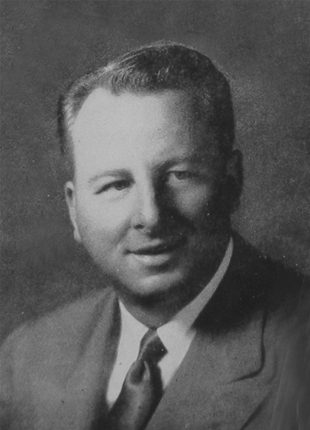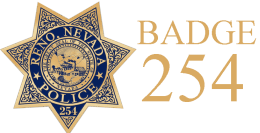
Clayton Phillips, Chief of Police
Reno Nevada 1947 - 1948
Clayton Phillips was appointed Chief of Police June 24, 1947 . Chief Phillips served as chief of police for the shortest period of time of any other chief of police for the City of Reno.
At the time of his appointment, the new chief was just short of 35 years of age which he would reach on July 21, and his appointment climaxes five years of service with the FBI.
A native of Clayton, Washington, he attended elementary school in Dayton, Nevada. He moved to Reno and started the eighth grade at Northside Junior High School, and was graduated from Reno High School.
He attended the University of Nevada where he was a prominent basketball player. He graduated from the institution in 1937.
Upon graduation from the University in 1937 he taught in the grade school at Gardnerville, and then spent the next four years in that community as principal of the grammar school.
A few months after Pearl Harbor, he joined the FBI and took that bureau’s intensive training courses. He was moved from time to time to various parts of the United States as an agent for the FBI, and was assigned to Reno as an agent one year ago.
Upon being appointed as Chief of Police, the new chief issued the following statement:
"I am deeply gratified by the confidence that has been placed in me, and am fully aware of the responsibilities that I am assuming. "I am looking forward to my work with the personnel of the Reno Police Department."
Chief. Phillips was married to the former Virginia Crosby. They had two daughters, and at the time lived at 1116 Wells Ave.
*** LINKS TO ADDITIONAL READING ***
1908 Reno Police Department Manual
Clayton Phillips, Chief of Police -- 1947-1948
The Reno Police Department with Alex Burke as Chief of Police.
The Reno Police Department with Alex Burke as Chief of Police.
“BATTLE OF THE CENTURY” – A LAW ENFORCEMENT CHALLENGE
by Jim Gibbs
All eyes turned to Reno on June 21, 1910 with the exciting news that the small city would soon be hosting the heavyweight championship battle between Jack Johnson and Jim Jeffries. The catch? The fight was just two weeks away.
Boxing promoter George Lewis “Tex” Rickard had originally intended to hold the highly-anticipated event in San Francisco, but a last-minute cancellation by wary California Governor James N. Gillette forced a change of venue. Reno’s leaders campaigned vigorously for the fight, convincing Rickard they could be ready in time for the scheduled date of July 4th.
The bout was promoted in advance as the “Fight of the Century”—a rather brash claim, considering the century was just a decade old—but the import of the fight was undeniable. By 1908, black fighter Jack Johnson had ascended to the top of the sport. Promoters eager to find a “Great White Hope” to seize his crown convinced Jim Jeffries to come out of retirement and reclaim the heavyweight title for white America. Having retired undefeated in 1904 as the heavyweight champion of the world, Jeffries was considered still deserving of the title by many, amid rampant racial prejudice.
The two competitors arrived in town in advance to train—Jim Jeffries at Moana Springs, south of town, and Jack Johnson to the west at Rick’s Resort. On June 23, workers began to construct a massive wooden amphitheater on land owned by Patrick Flanigan on East 4th Street, the site of the 1905 Hart-Root fight. On the eastern edge of city limits, the location was conveniently situated near both the Southern Pacific railroad tracks and the streetcar line joining Reno and Sparks. Supervised by San Francisco architect W.L. McLaughlin, a crew of up to 300 men at a time toiled for ten hours a day, supplied with whiskey breaks by contractor Charles Friedhoff.
It was the most publicized sporting event in American history to that date. Attendance was estimated at more than 20,000, with live telegraph coverage keeping the world riveted and nine cameramen documenting the event from different angles.
DOWNTOWN RENO - OVERWHELMING CROWDS OF PEOPLE
Center Street July 4, 1910. Looking North toward Commercial Row and the train station from East Second Street
Center Street July 4, 1910. Looking North toward Commercial Row and the train station from East Second Street
NEVADA PEACE OFFICERS JOIN TOGETHER TO HANDLE LARGEST CROWD EVER
The crowd came to see the “Battle of the Century”. Whether it came up to their expectations or not is not the debatable point. They came to Reno loaded with the fight spirit. It is estimated that the attendance of the fight was 20,000. The southern Pacific Railroad recorded 16,000 passengers delivered to Reno for the fight. At the time, Reno had a population of 10,867 and a police department of 10-12 individuals including Chief Burke.
There is also to be considered the fact that the “Battle of the Century” was one between representatives of races, rather than between individuals of the same color and condition. Racial prejudice was clearly shown in the conversations about the bout between Jeffries and Johnson.
July 4, 1910: Black fighter Jack Johnson knocks the “Great White Hope” Jim Jeffries to the canvas in Reno Nevada in front of an estimated crowd of 20,000 people
July 4, 1910: Black fighter Jack Johnson knocks the “Great White Hope” Jim Jeffries to the canvas in Reno Nevada in front of an estimated crowd of 20,000 people
With it all, the spectators, numbering twice the population of Reno uttered not a word of anger when the negro felled the Caucasian and was proclaimed his victor. That was not the situation throughout the United States as race riots erupted in various places. Maybe the crowd in Reno knew the truth as they watched the event. They witnessed the “Great White Hope” knocked to the canvas fairly by his black victor. But rumors of Jeffries being doped ran amuck and in many cities photos of the fight, especially the image of Johnson standing over Jeffries down on a knee clinging to the ropes, were banned.
It is well that the crowd in Reno was orderly, for there were hundreds of armed and determined deputies in the arena to make certain that the black man would receive fair treatment. While the Reno Police Department participated in maintaining order at the area which was on the Northeastern edge of town, the ultimate law enforcement responsibility on the day of the fight fell onto the shoulders of Sheriff Charley Ferrel.
To handle the crowd, Sheriff Ferrel reportedly deputized 100 plus special deputies. He also relied upon Reno Chief of Police, Burke, the Reno Township Constable Christie, United States Marshal Humphreys, Superintendent Cox of the state police and Assistant Chief Harrold of the Southern Pacific detective force.
All in all, the crowd dispersed about as quickly as they arrive and soon again the hotels had room available, the local merchants had cash in hand and the Reno Police Department was dealing with the occasional petty thief and the town drunks.

SHARE THIS PAGE!